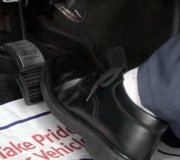Once the brake pedal went all the way to the floor, regardless of the reason, the master cylinder was most likely damaged and must be replaced. Crud and corrosion build up in the lower halves of the bores where the pistons don't normally travel. When the pedal is pushed all the way down, the lip seals run over that corrosion and can be ripped. Fluid will bypass the seals instead of being pushed down to the wheels. This happens often enough when an owner is surprised by a sudden leak that most mechanics will plan to need a rebuilt master cylinder when they figure the repair estimate. It also happens when an inexperienced mechanic thinks it's necessary to pedal-bleed with a helper, and the helper pushes the pedal too far. To avoid causing this problem, never push the pedal more than halfway to the floor unless the master cylinder is less than about a year old.
It is also possible there's just a lot of air in the lines yet. One trick is to pry a caliper piston back in to push the brake fluid and air up to the reservoir. That will get the air out of the front lines. You'll need to stroke the pedal a number of times to run the pistons back out. Again, don't push it over halfway.
"Gravity-bleeding" is the only method I use. Open the bleeder screws, then wait for brake fluid to start dribbling out. You'll usually need to loosen the reservoir cap so no vacuum builds up in the reservoir. Close each bleeder screw once fluid starts flowing. When all four are done, "irritate" the brake pedal a little by hand, then open each bleeder screw for a couple of seconds to expel any bubbles that washed into the calipers and wheel cylinders.
Very often on Ford products, brake fluid won't flow to the front calipers just from gravity. That's why people resort to pedal-bleeding. Instead, look at the front of the combination valve for a small pin, about the diameter of a finishing nail, sticking through a rubber cap. Pull that pin out with a pair of pliers. A tool is made to hold that pin out during the bleeding procedure. That opens the metering, (hold-off) valve which blocks fluid flow to front disc brakes until a little pressure has built up for the rear drum brakes. Most systems will bleed without opening that valve manually, but Fords often do not. (The combination valve is the brass block on the frame rail under the master cylinder. Follow the steel lines from the master cylinder to it. It also has one wire attached to it).
Tuesday, December 23rd, 2014 AT 3:05 PM



